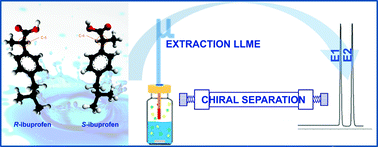A study of the enantiospecific degradation of ibuprofen in model aqueous samples using LLME-HPLC-DAD†
Abstract
Liquid–liquid microextraction (LLME) by high-performance liquid chromatography-diode array detection (HPLC-DAD) is a simple, rapid, efficient and environmentally friendly method that was developed to determine enantiomers of ibuprofen in aqueous environmental samples. The main parameters that affect the extraction efficiencies, such as the type and volume of the extractant, ultrasonication time, centrifugation time and salt addition, were investigated and optimized. After sample preparation, chromatographic separation of ibuprofen enantiomers was achieved on a Chiralcel® OJ-RH column using a mobile phase consisting of 0.05% trifluoroacetic acid in water : acetonitrile (65 : 35; v/v), with detection at 220 nm. Under optimal conditions, the linearity of the method for both enantiomers was in the range of 0.02–2 μg mL−1 with correlation coefficients from 0.9951 to 0.9953. The limit of quantification for the enantiomers was 0.02 μg mL−1. Good recoveries (82.9–95.2%) were obtained for the extraction and analysis of enantiomers of ibuprofen in water samples. The developed LLME-HPLC-DAD method was applied to the study of the enantiospecific degradation of ibuprofen in model water samples. The biodegradation of ibuprofen was not an enantiospecific process, because the removal efficiency for both enantiomers was similar (enantiomer 1–66% and enantiomer 2–69%).


 Please wait while we load your content...
Please wait while we load your content...